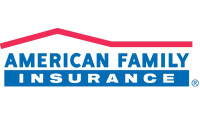Best Cheap Car Insurance for Bad Credit (2026)
Geico is the cheapest national auto insurance company for drivers with bad credit, at $305 per month for full coverage.
Find Cheap Auto Insurance Quotes
Best cheap auto insurance for bad credit
Also on this page:
Cheapest car insurance for bad credit
Geico offers the cheapest widely available auto insurance for drivers with bad credit.
However, American Family or NJM may be a better choice for many people.

Find Cheap Auto Insurance Quotes
- Geico charges around $305 per month for full coverage if you have a poor credit score. That's $107 per month cheaper than the national average.
- American Family has even cheaper rates, at $263 per month. However, American Family isn't available in every state.
- NJM is slightly more expensive, at $288 per month. However, NJM's full coverage policy comes with extra protection. And the company's excellent customer service may be worth the extra cost if you live in one of the five states where NJM is available.
Cheap full coverage auto insurance for bad credit
Company | Monthly rate | ||
|---|---|---|---|
| American Family | $263 | ||
| NJM | $288 | ||
| Geico | $305 | ||
| Travelers | $321 | ||
| Erie | $351 | ||
*USAA is only available to military members, veterans and some of their families.
Cheapest national company for drivers with poor credit: Geico
-
Editor's rating
- Full coverage with bad credit: $305/mo
- Full coverage with good credit: $187/mo
Geico is one of the largest car insurance companies in the country and offers some of the best rates for drivers with poor credit.
-
Cheapest widely available rates
-
Lots of discounts
-
Highly rated app
-
Mixed customer service reviews
Geico has the best bad credit car insurance quotes in 14 states — more than any other company besides USAA.
Drivers with poor credit pay an average of $305 per month with Geico. That's 26% cheaper than the national average for drivers with bad credit.
In addition, Geico offers lots of discounts to help lower your car insurance rates. For example, you can save by taking a defensive driving course or signing up for Geico's safe driving program, DriveEasy.
The main downside to Geico is its mixed customer service reviews. Although Geico gets fewer customer complaints than expected, it earned a poor score on J.D. Power's claims satisfaction survey. That means it may take longer to fix your car after a crash if you choose Geico.
Cheapest car insurance quotes for bad credit: American Family
-
Editor's rating
- Full coverage with bad credit: $263/mo
- Full coverage with good credit: $159/mo
American Family offers the cheapest rates for drivers with poor credit, but it's not available in 6 states.
-
Cheapest quotes
-
Numerous discounts
-
Good customer service
-
Not available everywhere
American Family has the cheapest bad-credit car insurance for most people. At $263 per month, full coverage from American Family costs $149 per month less than the national average.
American Family also offers lots of ways to help you save on your car insurance. This includes many discounts that are easy to get, such as buying a policy within seven days of getting a quote, signing up for automatic payments or switching to American Family from another company.
In addition, American Family customers are typically happy with the company's customer service. American Family gets around half as many complaints as other companies its size. And it earned an above-average score on J.D. Power's claims satisfaction survey.
Best customer service and perks: NJM
-
Editor's rating
- Full coverage with bad credit: $288/mo
- Full coverage with good credit: $168/mo
NJM's excellent customer service and coverage perks make it a top choice if you can get a policy.
-
Affordable quotes
-
Excellent customer service
-
Full coverage comes with extra perks
-
Only available in CT, MD, NJ, OH and PA
NJM has some of the best customer service in the car insurance industry.
It earned the third-highest score on J.D. Power's claims satisfaction survey, behind Erie and USAA. In addition, NJM gets 84% fewer complaints than an average company of its size. That means customers are typically very happy with the service they get from NJM.
Full coverage insurance from NJM costs around $288 per month for drivers with bad credit. While that's $25 per month more than American Family, NJM's full coverage policy comes with added protection that most companies charge extra for.
For example, when you get a policy with collision and comprehensive coverage, NJM automatically includes rental car reimbursement and new car replacement. It also covers your pet's medical bills if they're hurt in an accident while driving with you.
Best bad credit auto insurance for drivers with military ties: USAA
-
Editor's rating
- Full coverage with bad credit: $226/mo
- Full coverage with good credit: $125/mo
USAA has the cheapest rates for drivers with connections to the military.
-
Overall cheapest rates
-
Miltary-specific discounts
-
Excellent claims experience
-
Available only to military members, veterans and their families
-
Lots of customer complaints
USAA is the cheapest company overall for drivers with bad credit.
Full coverage auto insurance from USAA costs $226 per month for drivers with a poor credit score. However, policies are available only to a limited group: military members, veterans and some of their family members.
USAA earned the second-highest score on J.D. Power's claims satisfaction survey. That means USAA will help get your life back on track quickly after a crash. However, it gets 31% more complaints than an average company of its size. That means you may have a harder time dealing with billing disputes or making changes to your policy than you would with other companies.
Best car insurance for bad credit by state
Geico is the cheapest car insurance company for drivers with poor credit in 14 states, the most of any widely available company.
Travelers is the cheapest option in nine states, while Progressive has the best rates in seven states.
However, the cheapest company nationally isn't always the best option near you. In 11 states, smaller companies such as NJM, Westfield and American National have the best rates.

Find Cheap Auto Insurance Quotes Near You
Cheapest monthly full coverage quotes for bad credit
State | Cheapest company | Monthly rate |
|---|---|---|
| Alabama | Country Financial | $196 |
| Alaska | Geico | $244 |
| Arizona | Progressive | $278 |
| Arkansas | Alfa | $241 |
| California | n/a | n/a |
California, Hawaii, Massachusetts and Michigan don't allow car insurance companies to consider your credit score when setting insurance rates.
USAA has the cheapest bad credit car insurance in 26 states and Washington, D.C. However, only military members, veterans and some of their family members can buy insurance from USAA.
No-credit-check insurance companies
A few states, including California, Hawaii, Massachusetts and Michigan, do not allow insurance companies to use credit scores as a factor in setting car insurance rates.
Few insurance companies provide a car insurance policy without a soft credit check. Though they're rare, you might be able to find a local no-check car insurance company.
A few examples are Dillo in Texas and Cure in New Jersey and Pennsylvania. But they are exceptions, as 95% of auto insurance companies factor in credit history to determine your quotes, according to FICO.
Although some companies might not check your credit before giving you a quote, they will almost always check your credit before you sign up for your policy.
How to find cheap car insurance if you have bad credit
The best way to lower your insurance rates if you have bad credit is to work on improving your credit score, even though it's not an easy or fast process.
Make on-time payments: Making loan and credit card payments on time is one of the best ways to improve your credit, as payment history is the biggest factor in your credit score. It accounts for 35% of your credit score.
Paying your insurance bills on time will not help your credit score, but missing payments could hurt both your score and your rate.
Don't max out your credit cards: Using less than 30% of the credit you have is a great way to improve your credit rating.
The amount of credit you use compared to the credit available to you is known as your credit utilization ratio. Credit utilization accounts for up to 30% of your credit score. For example, if you have a credit card with $1,000 of available credit, you want to have a balance of no more than $300.
Beyond improving your credit, you can take a few more traditional steps to potentially lower your insurance rates.
- Take advantage of all discounts, such as good driver discounts, good student discounts or multiple policy discounts.
- Increase your deductibles. Increasing the deductible on your collision or comprehensive policy will lower your rates. Just be sure to choose a deductible you can easily afford in case of an accident or damage.
- Consider potential rate increases before filing a claim. Avoiding insurance claims can help keep rates reasonable. For minor issues you can afford to pay for, it may be better to handle the cost yourself.
- Shop around and get quotes from multiple car insurance companies to get the best deal.
Frequently asked questions
Can I get car insurance with bad credit?
Yes, but it will likely be more expensive. Poor credit raises your insurance rates by an average of 98%.
What is the cheapest car insurance for people with bad credit?
Geico is the cheapest national company for people with bad credit. It charges around $305 per month for full coverage. American Family, NJM and USAA have even cheaper rates, but not everyone can get a policy.
Can I get insurance with no credit check?
You can, but only in some instances. Few companies offer insurance without a credit check. Most cater to high-risk drivers, so their rates are often expensive anyway.
Insurance companies may not check your credit score in the four states that don't allow companies to use credit rating to calculate insurance rates — California, Hawaii, Massachusetts and Michigan.
How can I get cheaper car insurance quotes if I have bad credit?
The best path is working to improve your credit score by paying your bills on time. You can also look for discounts, shop around and scale back your coverage to reduce your insurance costs.
Methodology
To find the cheapest bad credit auto insurance, ValuePenguin editors collected quotes from the largest insurance companies in all states where credit is a factor for deciding car insurance quotes. Rates are for a 30-year-old man with a 2018 Honda Civic EX and a clean driving record.
Quotes are for a full coverage policy with collision and comprehensive coverage, along with higher liability limits than required in each state.
- Bodily injury liability: $50,000 per person and $100,000 per accident
- Property damage liability: $50,000 per accident
- Uninsured and underinsured motorist bodily injury: $50,000 per person and $100,000 per accident
- Comprehensive and collision: $500 deductible
This analysis used insurance rate data from publicly sourced insurer filings using Quadrant Information Services. These quotes should be used for comparative purposes only, as your rates may differ.
Senior Writer
Lindsay Bishop is a Senior Writer at ValuePenguin, where she educates readers about home, auto, renters, flood and motorcycle insurance.
Lindsay began her career in the insurance and financial industry in 2010. She was a licensed auto, home, life and health insurance agent and held Series 6 and 63 financial licenses.
After a hiatus from the financial sector, Lindsay returned to the industry as a content writer for ValuePenguin in 2021. She enjoys having the opportunity to help readers make smart decisions about their insurance so they can be prepared for anything life throws their way.
When Lindsay isn't writing about insurance, you can find her spending time with family, enjoying the outdoors on Sunday long runs or riding her Peloton.
How insurance helped Lindsay
As a homeowner for 15 years located in South Carolina, Lindsay has plenty of experience navigating the coastal insurance market and managing the claims process. That includes successfully negotiating a full roof replacement claim.
Expertise
- Home insurance
- Car insurance
- Flood insurance
- Renters insurance
- Motorcycle insurance
Referenced by
- CNBC
- Yahoo Finance
- Miami Herald
Education
- BS/BA Economics, University of Nevada Las Vegas
Editorial Note: The content of this article is based on the author's opinions and recommendations alone. It has not been previewed, commissioned or otherwise endorsed by any of our network partners.












